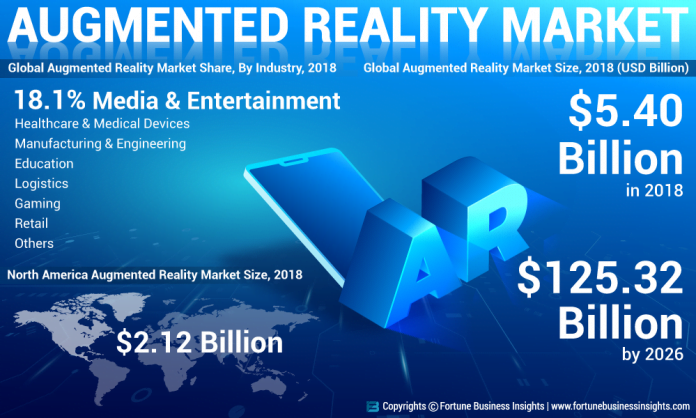The fictional days are long gone now. With technology taking centre stage in almost all aspects of our life, possibilities are being successfully converted into practicalities; at least most of them. Although fictional content has directed ‘impractical’ realities towards its audience, science has proven otherwise. As innovations have spearheaded their way into all industries, concepts such as augmented and virtual reality have been absolute game-changers. Ever since its inception, AR has derived applications that are not just limited to entertainment sector. AR is being used in the healthcare industry for predicting tumors and diseases as well as studying them through a virtual representation. Among the list of fascinating applications, certain end-uses in healthcare have stood out and at the current pace, AR looks set to dominate the ICT space. Driven by a wide range of applications, the global AR market is set to be worth $125 billion by 2026, states Fortune Business Insights in its latest report.
What the term ‘Augmented’ Really Means…
Although many are aware that AR is being used on a wide scale across the world, only a slightly lower majority really understands what the concept is. It is difficult to explain AR in a tech-savvy language. To put it in simpler terms, augmented reality is when another reality is embedded onto the current reality to study certain outcomes. Evidently, applications of this concept can range across diverse industries, accounting for the exceptional abilities that it holds. In textbook terms, the word augmented is used to describe something that is intensified or amplified to a considerable extent. Just like the dictionary meaning, augmented in AR is used to describe the amplification of current reality by adding another reality.
Revolutionary AR Taking Healthcare Industry by a Storm!
Although the concept is known for its application in the entertainment industry, it is currently making headlines across the healthcare industry. AR had certainly left a long lasting impression when it first burst onto the scene. The idea of a third world reality had understandably startled the human brain, but no one could have remotely predicted that it could also do wonders in the healthcare industry.
- Delivering Efficient Treatment: AR is not just limited to research and study, but is being used along with other concepts in treatment procedures. AR is used to implement virtual demonstrations for patients undergoing physical rehabilitation. Although this might not seem that significant on paper, the use of AR in physiotherapy is turning out to be hugely beneficial. Patients are able to sync in tandem with these demonstrations and thus speed up the recovery process in physical injuries.
- Integrating Advanced Concepts: The most obvious application is to try out something onto something and see whether it is working through predictive outcomes. Just like this, AR is being used to study the integration of modern technologies in healthcare devices and equipment by major companies across the globe. This seems to help companies avoid losses of failures and trials and this save a lot of money as well as time. The development lifecycle span of any device in the healthcare industry can be reduced to a great extend through the integration of AR at an early stage.
- Assisting Surgical Procedures: We are all quite aware of the importance ‘precision’ holds in surgical procedures. With very little or almost no room for error, surgeons readily welcome all the help they can get in terms of surgical efficacies. From conducting minimally invasive surgeries to severe applications such as locating tumors in sensitive body parts, AR holds huge significance in surgical procedures.
Although it is still early days, AR has managed to attract considerable attention from across the world. With countless applications, there has been an increase in the studies conducted through and on AR in the past decade. There is no doubt that AR has created a sense of excitement not just among professionals, but also within the observers and consumers. Companies such as Google and Facebook are actively investing in AR as well as AR-based concepts. With numerous possibilities, augmented reality has the potential to attract billion-dollar investments in the coming years. If early predictions are to be believed, the future looks exciting and AR could just be the next big thing in the ICT space.
Author’s Bio:
Tanay Bhalla is a highly-driven writer with extensive knowledge of diverse industries. His approach to writing is simple, intended to ensure a seamless read.







